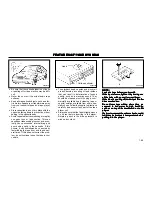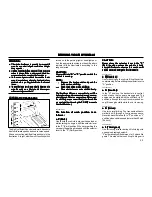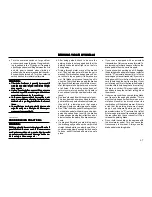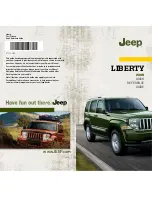
DRIVING YOUR HYUNDAI
DRIVING YOUR HYUNDAI
DRIVING YOUR HYUNDAI
DRIVING YOUR HYUNDAI
DRIVING YOUR HYUNDAI
2- 13
Tongue
187.4 (85)
100 (45.3)
tification plate (see page 8-1). The total
tification plate (see page 8-1). The total
tification plate (see page 8-1). The total
tification plate (see page 8-1). The total
tification plate (see page 8-1). The total
gross vehicle weight is the combined
gross vehicle weight is the combined
gross vehicle weight is the combined
gross vehicle weight is the combined
gross vehicle weight is the combined
weight of the vehicle, driver, all passen-
weight of the vehicle, driver, all passen-
weight of the vehicle, driver, all passen-
weight of the vehicle, driver, all passen-
weight of the vehicle, driver, all passen-
gers and their luggage, cargo, hitch, trailer
gers and their luggage, cargo, hitch, trailer
gers and their luggage, cargo, hitch, trailer
gers and their luggage, cargo, hitch, trailer
gers and their luggage, cargo, hitch, trailer
tongue load and other optional equip-
tongue load and other optional equip-
tongue load and other optional equip-
tongue load and other optional equip-
tongue load and other optional equip-
ment.
ment.
ment.
ment.
ment.
3.
3.
3.
3.
3. The front or rear axle weight must not
The front or rear axle weight must not
The front or rear axle weight must not
The front or rear axle weight must not
The front or rear axle weight must not
exceed the Gross Axle Weight Rating
exceed the Gross Axle Weight Rating
exceed the Gross Axle Weight Rating
exceed the Gross Axle Weight Rating
exceed the Gross Axle Weight Rating
(GAWR) shown on the vehicle identifica-
(GAWR) shown on the vehicle identifica-
(GAWR) shown on the vehicle identifica-
(GAWR) shown on the vehicle identifica-
(GAWR) shown on the vehicle identifica-
tion plate (see page 8-1). It is possible that
tion plate (see page 8-1). It is possible that
tion plate (see page 8-1). It is possible that
tion plate (see page 8-1). It is possible that
tion plate (see page 8-1). It is possible that
your towing package does not exceed the
your towing package does not exceed the
your towing package does not exceed the
your towing package does not exceed the
your towing package does not exceed the
GVWR but exceeds the GAWR.
GVWR but exceeds the GAWR.
GVWR but exceeds the GAWR.
GVWR but exceeds the GAWR.
GVWR but exceeds the GAWR.
Improper trailer loading and/or too much
Improper trailer loading and/or too much
Improper trailer loading and/or too much
Improper trailer loading and/or too much
Improper trailer loading and/or too much
luggage in the trunk can overload the rear
luggage in the trunk can overload the rear
luggage in the trunk can overload the rear
luggage in the trunk can overload the rear
luggage in the trunk can overload the rear
axle. Redistribute the load and check the
axle. Redistribute the load and check the
axle. Redistribute the load and check the
axle. Redistribute the load and check the
axle. Redistribute the load and check the
axle weight again.
axle weight again.
axle weight again.
axle weight again.
axle weight again.
Gross axle weight
Gross vehicle weight
SSA2200D
CAUTION:
CAUTION:
CAUTION:
CAUTION:
CAUTION:
The following specifications are recommend-
The following specifications are recommend-
The following specifications are recommend-
The following specifications are recommend-
The following specifications are recommend-
ed when towing a trailer. The loaded trailer
ed when towing a trailer. The loaded trailer
ed when towing a trailer. The loaded trailer
ed when towing a trailer. The loaded trailer
ed when towing a trailer. The loaded trailer
weigh cannot safely exceed the values in the
weigh cannot safely exceed the values in the
weigh cannot safely exceed the values in the
weigh cannot safely exceed the values in the
weigh cannot safely exceed the values in the
chart below.
chart below.
chart below.
chart below.
chart below.
Lbs. (kg)
Maximum Towable Weight
Trailer
1874(850)
1000(453)
WARNING:
WARNING:
WARNING:
WARNING:
WARNING:
Improperly loading your car and trailer can
Improperly loading your car and trailer can
Improperly loading your car and trailer can
Improperly loading your car and trailer can
Improperly loading your car and trailer can
serious affect its steering and braking perfor-
serious affect its steering and braking perfor-
serious affect its steering and braking perfor-
serious affect its steering and braking perfor-
serious affect its steering and braking perfor-
mance causing a crash in which could cause
mance causing a crash in which could cause
mance causing a crash in which could cause
mance causing a crash in which could cause
mance causing a crash in which could cause
serious injured or killed.
serious injured or killed.
serious injured or killed.
serious injured or killed.
serious injured or killed.
C190F01S-AAT
Trailer or Vehicle Towing Tips
Trailer or Vehicle Towing Tips
Trailer or Vehicle Towing Tips
Trailer or Vehicle Towing Tips
Trailer or Vehicle Towing Tips
1. Before towing, check hitch and safety chain
connections as well as proper operation of
the trailer running lights, brake lights, and turn
signals.
2. Always drive your vehicle at a moderate
speed. (Less than 60 mph)
3. Trailer towing requires more fuel than normal
conditions.
4. To maintain engine braking efficiency and
electrical charging performance, do not use
fifth gear (manual transaxle) or overdrive
(automatic transaxle).
5. Always secure items in the trailer to prevent
load shift while driving.
6. Check the condition and air pressure of all
tires on the trailer and your car. Low tire
pressure can seriously affect the handling.
Also check the spare tire.
7. The vehicle/trailer combination is more af-
fected by crosswind and buffeting.
When being passed by a large vehicle, keep
a constant speed and steer straight ahead. If
there is too much wind buffeting slow down to
get out of the other vehicle's air turbulence.
8. When parking your car and trailer, especially
on a hill, be sure to follow all the normal
precautions. Turn your front wheel into the
curb, set the parking brake firmly, and put the
transaxle in 1st or Reverse (manual) or Park
(automatic). In addition, place wheel chocks
at each of the trailer's tires.
9. If the trailer has electric brakes, start your
vehicle and trailer moving, and then apply the
trailer brake controller by hand to be sure the
brakes are working. This lets you check your
electrical connection at the same time.
10.During your trip, occasionally check to be
sure that the load is secure, and that the
lights and any trailer brakes are still working.
11.Avoid jerky starts, sudden acceleration or
sudden stops.
12.Avoid sharp turns and rapid lane changes.
13.Avoid holding the brake pedal down too long
or too frequently. This could cause the brakes
to overheat, resulting in reduced braking effi-
ciency.
14.When going down a hill, shift into a lower gear
and use the engine braking effect.
When ascending a long grade, downshift the
transaxle to a lower gear and reduce speed to
reduce chances of engine overloading and/or
overheating.
With Brake
Without Brake
















































